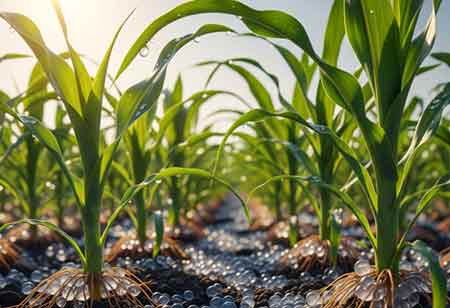Thank you for Subscribing to Agri Business Review Weekly Brief
Customizing Hydrogel Solutions for Crop-Specific Needs
Hydrogels enhance agriculture by improving water and nutrient management, tailored to specific crop needs, promoting efficiency and sustainability in response to climate change challenges.

By
Agri Business Review | Friday, October 17, 2025
Stay ahead of the industry with exclusive feature stories on the top companies, expert insights and the latest news delivered straight to your inbox. Subscribe today.
The global agricultural sector faces the pressing imperative of increasing crop yields while minimizing resource consumption, a necessity driven by the demands of a growing population and the challenges of climate change. Precision agriculture, which tailors farming methodologies to specific field conditions, presents a viable trajectory for progress, with advanced materials assuming a pivotal role in this paradigm shift. Among these, hydrogels are gaining prominence as a powerful tool for enhancing soil health and improving water management. Functioning as microscopic reservoirs when integrated into the soil, hydrogels sequester water and nutrients, subsequently releasing them to plants on an as-needed basis, thereby directly ameliorating water scarcity. By mitigating runoff and evaporation, they enhance water-use efficiency, enabling agricultural producers to achieve greater output with diminished resource expenditure.
While the fundamental properties of hydrogels are beneficial across the board, a one-size-fits-all approach is not the most effective strategy. The true potential of this technology lies in its customization for crop-specific needs. Different crops have unique requirements for water, nutrients, and soil conditions. By tailoring the properties of hydrogels, we can create solutions that are precisely matched to the demands of a particular plant, leading to more targeted and effective results. This customization can involve altering the hydrogel's chemical composition, physical structure, and degradation profile.
For example, crops that are highly sensitive to water stress, such as certain vegetables or fruits, may benefit from hydrogels designed for maximum water retention and a slow, controlled release. These hydrogels can act as a buffer against periods of drought, ensuring a steady supply of moisture to the roots. In contrast, crops that thrive in well-drained soils, such as some root vegetables, may require hydrogels with a lower swelling capacity that primarily focus on nutrient delivery rather than water storage.
Engineering for Nutrient and Biostimulant Delivery
Beyond their role in water management, hydrogels can also be engineered to serve as carriers for essential nutrients and beneficial microorganisms. Fertilizers can be encapsulated within the hydrogel matrix, preventing them from being leached away by rain or irrigation. This slow-release mechanism ensures that nutrients are delivered directly to the plant's root zone over an extended period, improving nutrient-use efficiency and reducing the environmental impact associated with fertilizer runoff. The hydrogel acts as a protective shield, preserving the integrity of the nutrients and ensuring their availability when the plant needs them most.
Similarly, hydrogels can be designed to deliver biostimulants, which are substances that enhance plant growth and development without acting as fertilizers. These can include beneficial bacteria, fungi, or plant hormones. By incorporating these biostimulants into the hydrogel, they are protected from degradation and can be released slowly into the soil, promoting a healthier root system and increased stress tolerance. This targeted delivery is especially valuable for high-value crops that require careful management to achieve optimal quality and yield.
Controlling Degradation for Environmental Stewardship
A critical aspect of customizing hydrogel solutions is controlling their degradation. The ideal hydrogel should be durable enough to perform its function throughout the plant's growth cycle, but it should also break down into harmless components once its purpose is fulfilled. This ensures that there is no long-term accumulation of synthetic materials in the soil. The degradation rate can be precisely controlled by adjusting the type of polymer used and the cross-linking density of the hydrogel network.
For annual crops with a short growth cycle, a hydrogel designed for rapid degradation may be the most suitable option. These hydrogels would break down quickly after harvest, leaving behind a clean soil profile for the next planting season. In contrast, for perennial crops or long-term applications, a hydrogel with a slower degradation rate would be more suitable, providing benefits over multiple seasons. This ability to match the hydrogel's lifespan to the crop's lifecycle is a significant advancement, as it allows for both immediate effectiveness and long-term environmental responsibility.
Integrating Hydrogels into Modern Farming Practices
The successful integration of custom hydrogel solutions into modern farming practices requires a seamless approach. These materials can be applied in various forms, such as powders, granules, or liquid suspensions, allowing for flexibility in application methods. They can be incorporated into the soil during planting, applied through irrigation systems, or used as a seed coating to give young plants a strong start. The choice of application method depends on the specific crop, the scale of the operation, and the desired outcome.
As the understanding of soil science and plant physiology continues to advance, the potential for customizing hydrogel solutions will only grow. By moving beyond generic products and embracing a precision-based approach, we can create more effective and sustainable agricultural systems. This technology represents a powerful tool for building a more resilient food supply, capable of withstanding the environmental pressures of the 21st century. The future of agriculture is not just about what is grown, but also how it is grown, and custom hydrogel solutions are at the forefront of this transformation.
The future of agriculture is undeniably tied to innovation and the strategic application of advanced materials. The development of custom hydrogels represents a significant leap forward in this regard. Designing these polymer networks to meet the unique demands of different crops unlocks new levels of efficiency, productivity, and sustainability. This tailored approach enables a more nuanced and effective management of water and nutrients, two of the most critical resources in farming.





